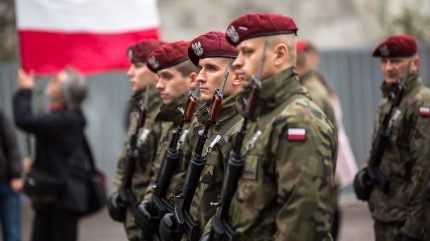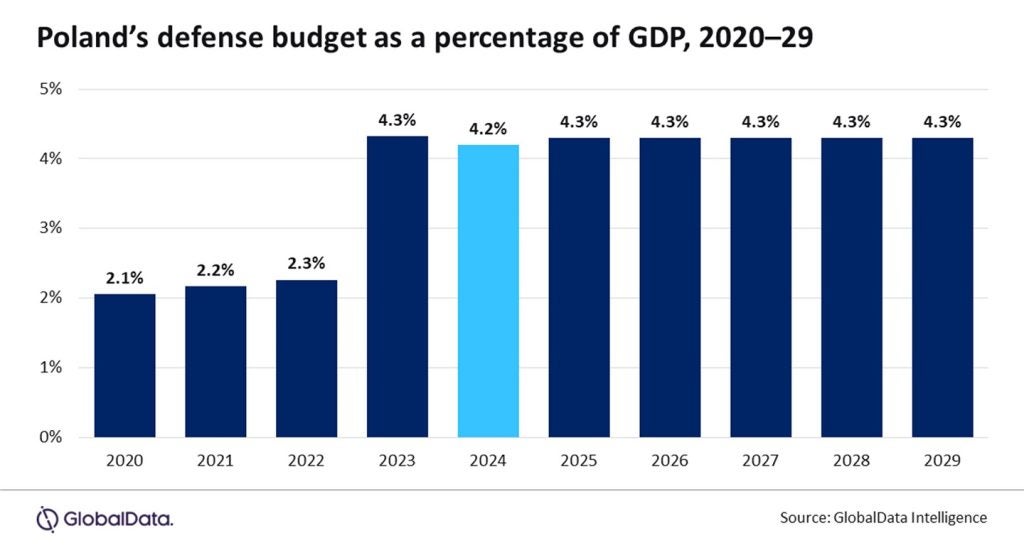
In a move to fortify its defences and bolster Nato’s security framework, Poland is set to ramp up its defence spending over the coming years, reaching an estimated $48.5bn (194.5bn zlotys) by 2029.
This initiative comes amidst mounting regional uncertainties following Russia’s illegal invasion of Ukraine, signalling Poland’s proactive stance in safeguarding European security.
Poland’s defence spending surge
According to the recent “Poland Defense Market 2024-2029” report by GlobalData, Poland’s defence budget is projected to rise steadily from $36.4bn in 2024 to $39.9bn by 2025, marking a commitment to enhancing its military readiness.
Fox Walker, a Defence Analyst at GlobalData, emphasised Poland’s heightened focus on military modernisation and readiness, stating, “For at least the rest of the decade, Poland will spend at least 4.3% of its GDP on defence each year, which would place it on par with the US and put it significantly higher than the vast majority of all other NATO member countries.”

The surge in defence expenditure is expected to prioritise key sectors such as missiles, missile defence systems, artillery, and military vehicles.
Significant investments include acquiring advanced systems like the Patriot air defence system, Borsuk infantry fighting vehicle, and the Homar-A multiple launch rocket system – a HIMAR variant. These acquisitions bolster Poland’s defence capabilities and stimulate domestic economic growth through enhanced defence supply chains.
Defence companies such as Leonardo have boosted Poland’s defence capabilities by launching the AW149 helicopter production line at PZL-Świdnik, marking a step towards enhancing local defence industry self-reliance. This initiative allows Poland to manufacture AW149 helicopters domestically within two years of contract signing, promoting job growth and technology transfer.
Concurrently, Poland has finalised a deal with South Korea to produce 180 K2 Black Panther main battle tanks locally, reflecting a broader strategy of integrating international partnerships with domestic production goals.
Nato’s largest land army with 300,000 personnel
Beyond hardware acquisitions, Poland is also committing resources to strengthen its military personnel. With plans to increase military personnel spending to $17.8bn by 2029, Poland aims to expand its armed forces to 300,000 personnel, positioning itself as an intimidating land force within Nato.
Prime Minister Donald Tusk has highlighted the urgency of fortifying European defence capabilities, warning of a “prewar” era in Europe. This sentiment indicates Poland’s broader strategic objective of assuming a leadership role within Nato, aligning its defence policy closely with Western allies amidst shifting global dynamics.
Walker elaborated on Poland’s aspirations, noting, “Poland aims to become NATO’s largest land army in Europe by eventually achieving a total force strength of 300,000. A military expansion of this size, combined with Poland’s substantial acquisition investments, will make Poland an armed force to be reckoned with.”
As Poland charts a course towards bolstering its defence capabilities, its proactive stance reflects a broader effort within Nato to strengthen transatlantic security cooperation in the face of evolving geopolitical challenges. With ambitious modernisation plans and a robust defence budget trajectory, Poland is poised to play a role in shaping the future of European security architecture.



